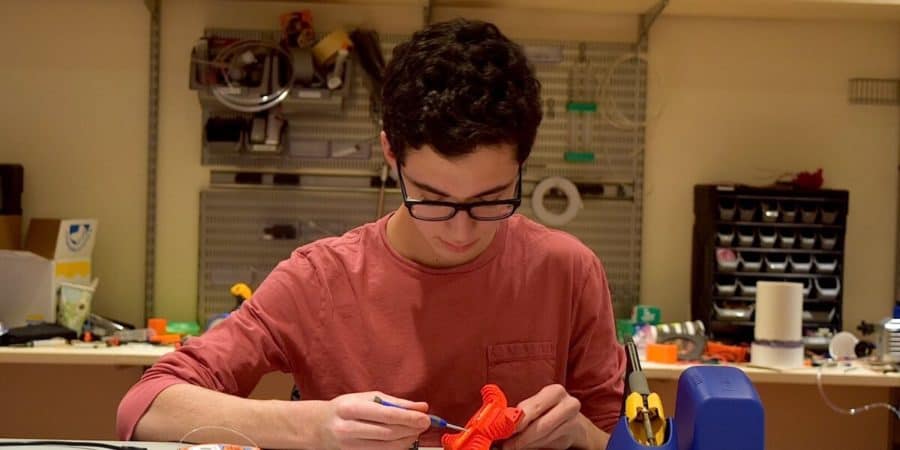Aidan Leitch loves to make stuff.
A junior studying mechanical engineering at the USC Viterbi School of Engineering, Leitch spends his free time on projects ranging from weaving fuzzy rugs designed on MATLAB to 3D-printing balls optimized for maximum bouncing.
Recently, Leitch developed a process to turn paper and cardboard into a wood-like material that he hopes could provide a valuable alternative to plastic in product packaging or single-use cutlery.
“3D printing and other advanced manufacturing techniques are already revolutionizing how we fabricate everything,” Leitch said. “Though often this means fancy new plastics or composite materials, I think advanced manufacturing offers new opportunities for traditional and sustainable materials, like paper, too. I hope my project proves this and inspires other to explore these opportunities.”
Leitch’s technique allows cardboard, newspaper, plain white paper, or egg carton packaging to be pressed into a dense new material using 3D molds. This final material is rigid, fully biodegradable, and can be molded into nearly any three-dimensional shape.
“We’re pretty used to paper being soft, thin, and flat, but the pressed pulp is none of the above,” Leitch said. “It doesn’t tear, burn, or crush as easily as the paper it was made from. But just like most paper, the material is easily compostable.”
Leitch’s inspiration for this project came from his internship at design and prototyping firm 3D Brooklyn in the summer of 2018. He witnessed a similar technique used by Will Haude, 3D Brooklyn’s co-founder and chief design officer, who had done some preliminary experiments with molding cardboard shreds with PVA glue. Leitch refined this process by turning the cardboard to a pulp, which allowed for greater molding detail and a more consistent process overall.
Leitch has created dishes, desk organizers, and pencil holders, but he ultimately hopes this pressed pulp material can be used as a replacement for plastic. According to him, his material is much stronger than existing paper-based substitutions for plastic and can have more intricate designs.
Leitch’s process works by taking wet paper pulp and a water-soluble binding material and compressing it in a 3D printed mold. The pulp is made by combining shredded plain white paper, cardboard, or newspaper with a binding agent — Leitch usually uses rice paste — adding water, and blending it into a homogenous mixture. This pulp is then placed into a 3D printed mold, which is compressed using a vice, clamp, or other pressing device to remove most of the water, leaving the binder to hold the paper fibers together.
Leitch spent this past summer interning for Zume Inc., a manufacturing technology company focused on reducing the plastic waste with economically viable substitutes for plastic packaging. According to Zume’s vice president of engineering, Josh Goldberg, his interest and innovative independent work in this area was a deciding factor in accepting him for a summer internship.
“Aidan was a key contributor over the summer to multiple projects, and everyone here enjoyed having him as a member of our team,” Goldberg said. “He not only dove into what he knows with respect to design and 3D printing but also took charge on new projects that made a material impact on our business.”
“I’ve liked to make stuff for pretty much as long as I can remember. Whether it was LEGOs or 3D printers, I always found some kind of means to build,” said Leitch.
Leitch said he was drawn to USC because it seemed like a place where he’d have the flexibility to pursue interests outside of strictly engineering.
“I got the sense that I could be an engineering student there without only being an engineering student,” Leitch said. “I’ve liked that I’ve been able to explore a few different avenues of interest through my coursework. So far I’ve taken classes in the (USC) Roski School (of Fine Arts) and the School of Architecture and found they offered a dimensionality that complimented my engineering classes.”
On campus, Leitch is a member of USC Makers, a USC Viterbi club that brings engineering students together to work on cool projects, from robotic dogs to bicycle theft prevention security systems. Leitch joined Makers his freshman year and has since become a project manager for the club. Last year, he led two projects: overseeing the development of a 3D light painting machine as well as a virtual telepresence robot.
Leitch also does freelance prototyping and fabrication consultation, along with frequently teaching technology classes at local libraries as well as at MacInspires, a makerspace in New York.
“I actually learned 3D printing and electronics from similar classes when I was even younger, so I see it as my duty to pass that knowledge on down the line,” Leitch said. I’ve always found it super rewarding to teach other young folks the same skills that have empowered and emboldened me.”
Leitch isn’t quite sure what he wants to do in the future, but he’s excited to keep on creating, building, and innovating.


